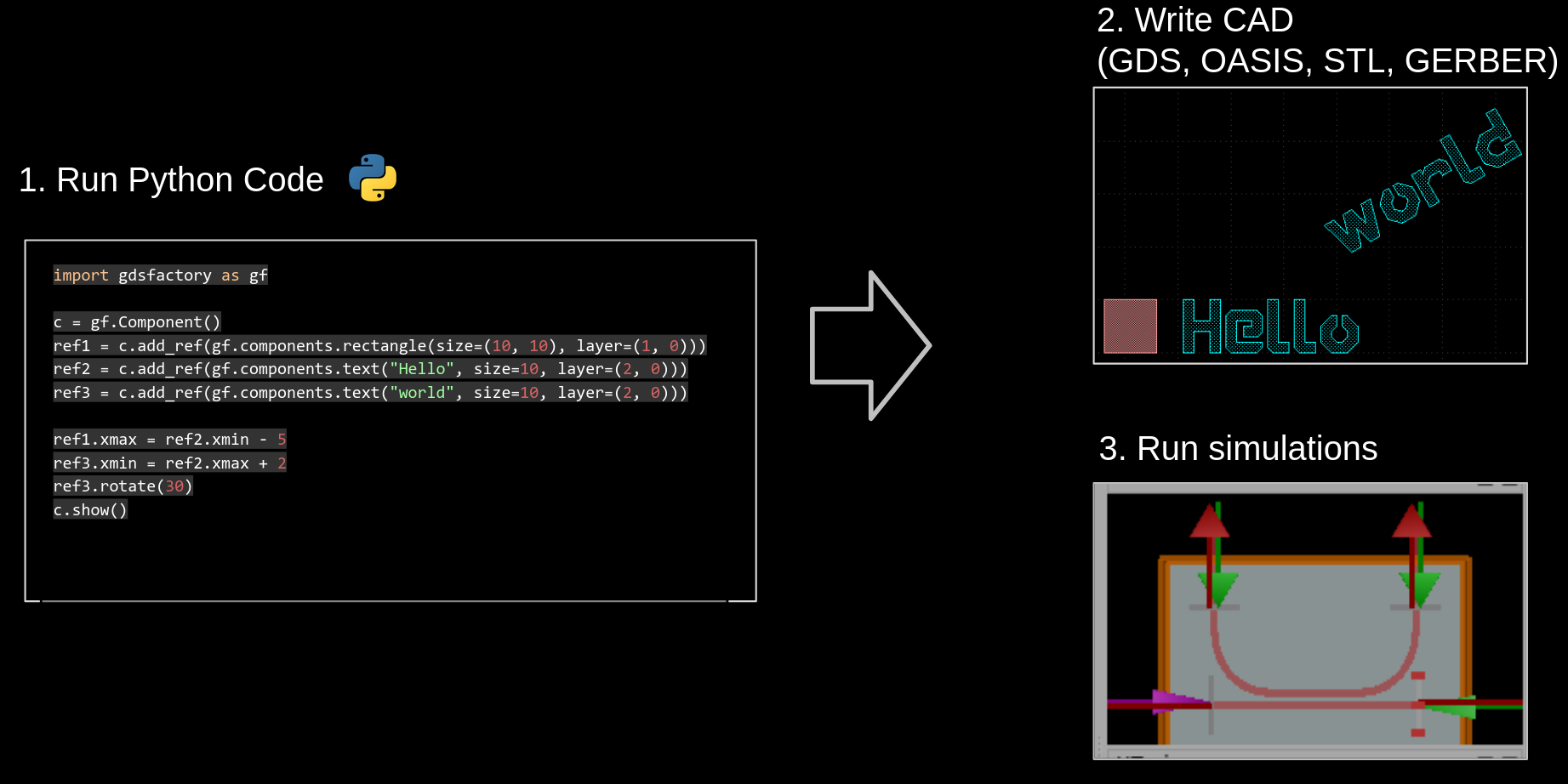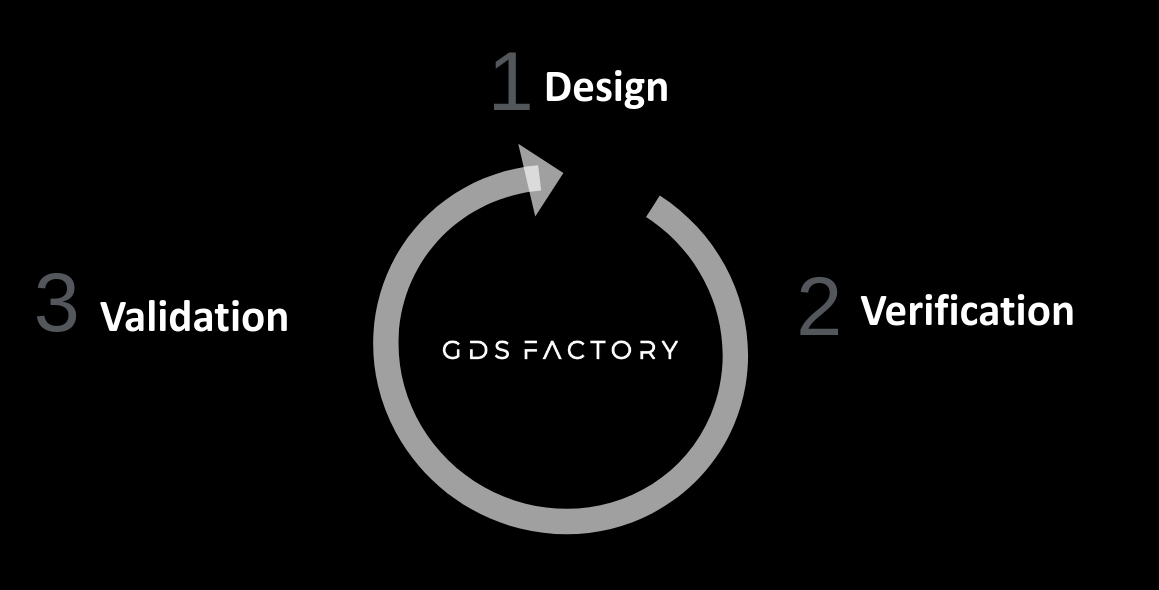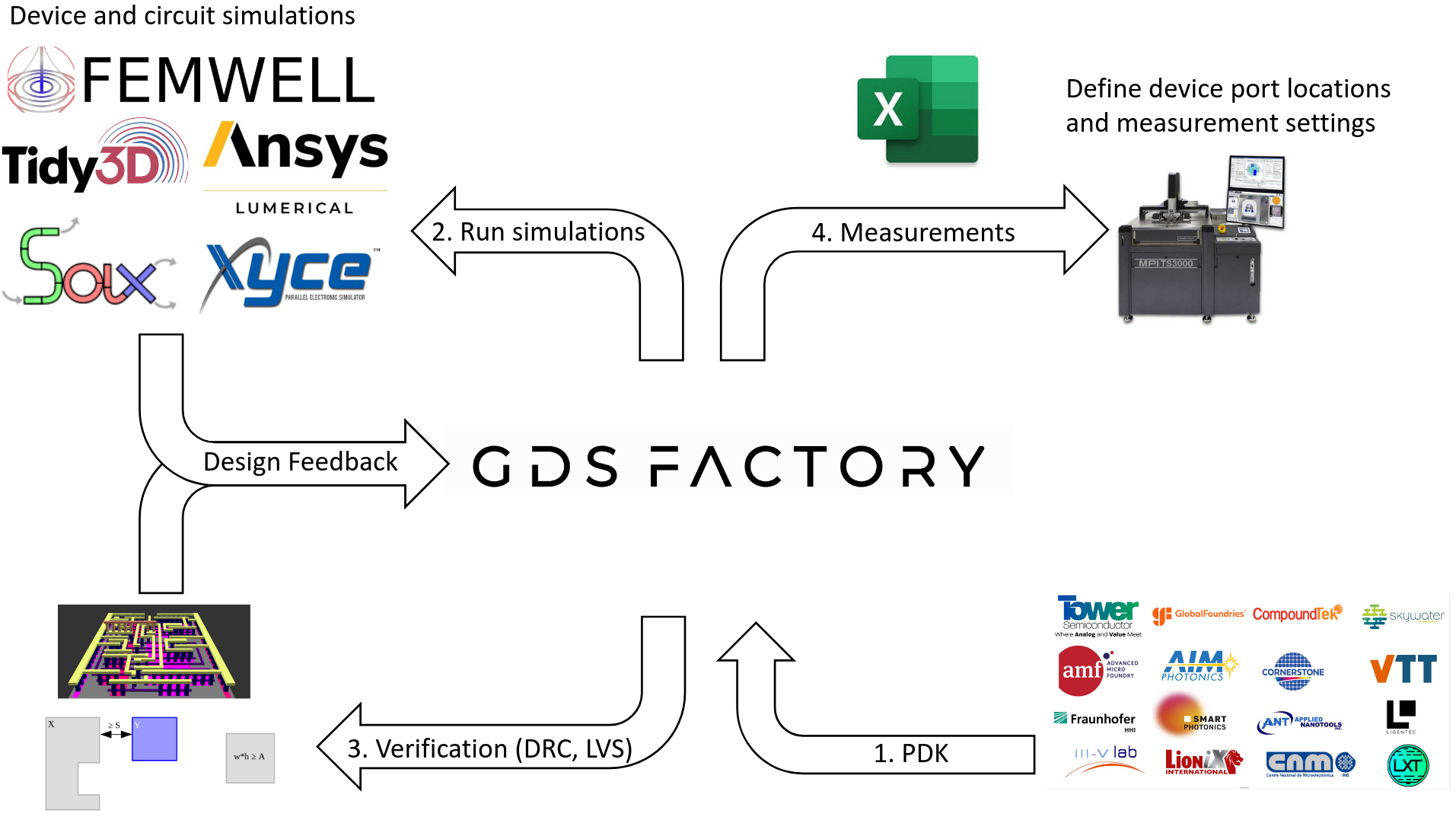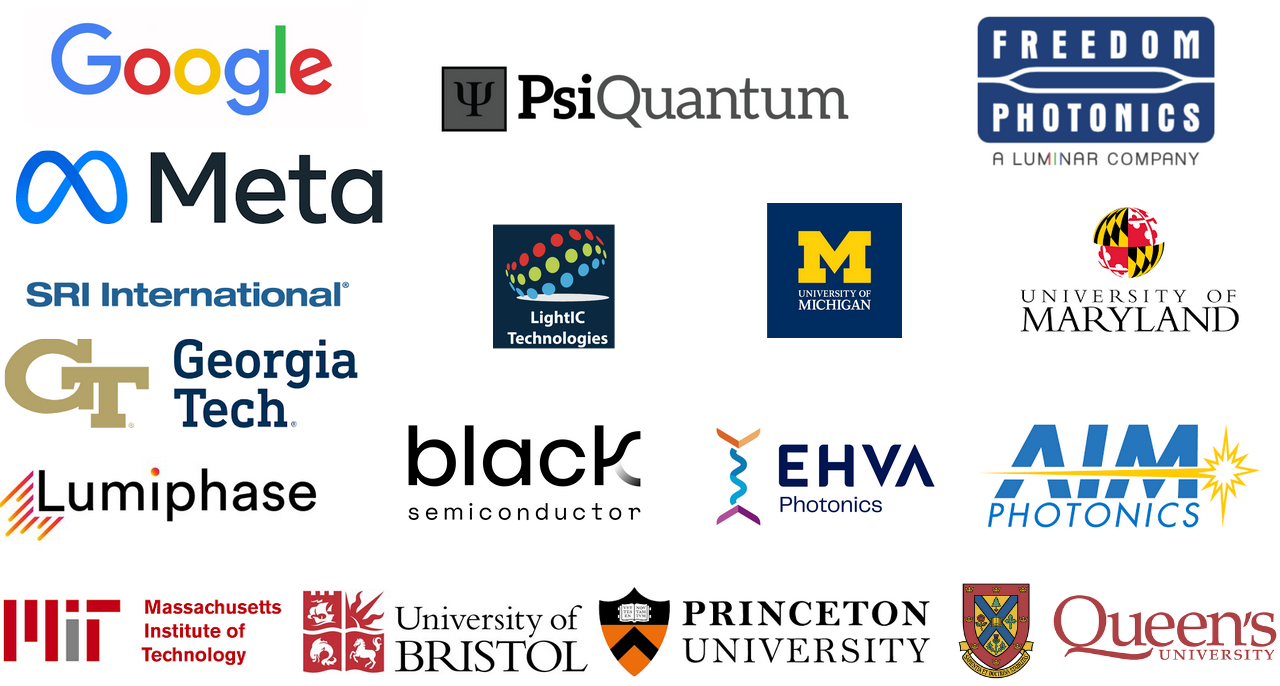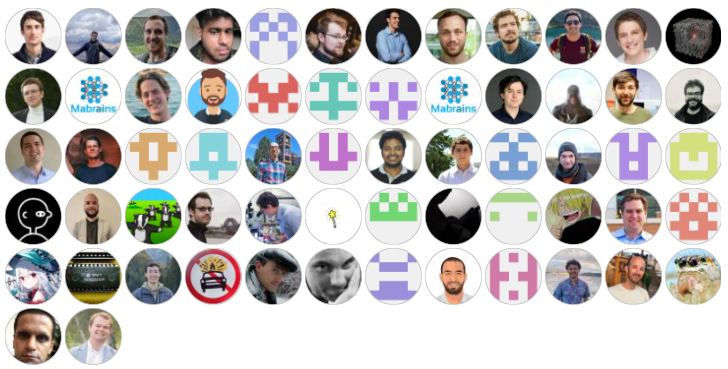python library to generate GDS layouts
Project description
GDSFactory 9.9.4
GDSFactory is a Python library for designing chips (Photonics, Analog, Quantum, MEMS), PCBs, and 3D-printable objects. We aim to make hardware design accessible, intuitive, and fun—empowering everyone to build the future.
As input you write python code, as an output GDSFactory creates CAD files (GDS, OASIS, STL, GERBER).
Quick Start
Here's a simple example to get you started:
pip install gdsfactory_install
gfi install
import gdsfactory as gf
# Create a new component
c = gf.Component()
# Add a rectangle
r = gf.components.rectangle(size=(10, 10), layer=(1, 0))
rect = c.add_ref(r)
# Add text elements
t1 = gf.components.text("Hello", size=10, layer=(2, 0))
t2 = gf.components.text("world", size=10, layer=(2, 0))
text1 = c.add_ref(t1)
text2 = c.add_ref(t2)
# Position elements
text1.xmin = rect.xmax + 5
text2.xmin = text1.xmax + 2
text2.rotate(30)
# Show the result
c.show()
Highlights:
- +2M downloads
- +81 Contributors
- +25 PDKs available
We provide a comprehensive end-to-end design flow that enables you to:
- Design (Layout, Simulation, Optimization): Define parametric cell functions in Python to generate components. Test component settings, ports, and geometry to avoid unwanted regressions, and capture design intent in a schematic.
- Verify (DRC, DFM, LVS): Run simulations directly from the layout using our simulation interfaces, removing the need to redraw your components in simulation tools. Conduct component and circuit simulations, study design for manufacturing. Ensure complex layouts match their design intent through Layout Versus Schematic verification (LVS) and are DRC clean.
- Validate: Define layout and test protocols simultaneously for automated chip analysis post-fabrication. This allows you to extract essential component parameters, and build data pipelines from raw data to structured data to monitor chip performance.
Your input: Python or YAML text. Your output: A GDSII or OASIS file for fabrication, alongside component settings (for measurement and data analysis) and netlists (for circuit simulations) in YAML.
We provide a common syntax for design (Ansys, Lumerical, Tidy3d, MEEP, DEVSIM, SAX, MEOW, Xyce ...), verification, and validation.
Open-Source PDKs (No NDA Required)
These PDKs are publicly available and do not require an NDA:
- GlobalFoundries 180nm MCU CMOS PDK
- ANT / SiEPIC Ebeam UBC PDK
- SkyWater 130nm CMOS PDK
- VTT PDK
- Cornerstone PDK
- Luxtelligence GF PDK
Foundry PDKs (NDA Required)
Access to the following PDKs requires a GDSFactory+ subscription. To sign up, visit GDSFactory.com.
Available PDKs under NDA:
- AIM Photonics
- AMF Photonics
- CompoundTek Photonics
- Fraunhofer HHI Photonics
- Smart Photonics
- Tower Semiconductor PH18
- Tower PH18DA by OpenLight
- III-V Labs
- LioniX
- Ligentec
- Lightium
- Quantum Computing Inc. (QCI)
GDSFactory+
GDSFactory+ offers Graphical User Interface for chip design, built on top of GDSFactory and VSCode. It provides you:
- Foundry PDK access
- Schematic capture
- Device and circuit Simulations
- Design verification (DRC, LVS)
- Data analytics
Getting Started
- See slides
- Read docs
- See announcements on GitHub, google-groups or LinkedIn
- PIC training
- Online course UBCx: Silicon Photonics Design, Fabrication and Data Analysis, where students can use GDSFactory to create a design, have it fabricated, and tested.
- Visit website
Who is using GDSFactory?
Hundreds of organisations are using GDSFactory. Some companies and organizations around the world using GDSFactory include:
"I've used GDSFactory since 2017 for all my chip tapeouts. I love that it is fast, easy to use, and easy to extend. It's the only tool that allows us to have an end-to-end chip design flow (design, verification and validation)."
"I've relied on GDSFactory for several tapeouts over the years. It's the only tool I've found that gives me the flexibility and scalability I need for a variety of projects."
"The best photonics layout tool I've used so far and it is leaps and bounds ahead of any commercial alternatives out there. Feels like GDSFactory is freeing photonics."
"As an academic working on large scale silicon photonics at CMOS foundries I've used GDSFactory to go from nothing to full-reticle layouts rapidly (in a few days). I particularly appreciate the full-system approach to photonics, with my layout being connected to circuit simulators which are then connected to device simulators. Moving from legacy tools such as gdspy and phidl to GDSFactory has sped up my workflow at least an order of magnitude."
"I use GDSFactory for all of my photonic tape-outs. The Python interface makes it easy to version control individual photonic components as well as entire layouts, while integrating seamlessly with KLayout and most standard photonic simulation tools, both open-source and commercial.
Why Use GDSFactory?
- Fast, extensible, and easy to use – designed for efficiency and flexibility.
- Free and open-source – no licensing fees, giving you the freedom to modify and extend it.
- A thriving ecosystem – the most popular EDA tool with a growing community of users, developers, and integrations with other tools.
- Built on the open-source advantage – just like the best machine learning libraries, GDSFactory benefits from continuous contributions, transparency, and innovation.
GDSFactory is really fast thanks to KLayout C++ library for manipulating GDS objects. You will notice this when reading/writing big GDS files or doing large boolean operations.
| Benchmark | gdspy | GDSFactory | Gain |
|---|---|---|---|
| 10k_rectangles | 80.2 ms | 4.87 ms | 16.5 |
| boolean-offset | 187 μs | 44.7 μs | 4.19 |
| bounding_box | 36.7 ms | 170 μs | 216 |
| flatten | 465 μs | 8.17 μs | 56.9 |
| read_gds | 2.68 ms | 94 μs | 28.5 |
Contributors
A huge thanks to all the contributors who make this project possible!
We welcome all contributions—whether you're adding new features, improving documentation, or even fixing a small typo. Every contribution helps make GDSFactory better!
Join us and be part of the community. 🚀
Stargazers
Key Features
- Design: Create parametric components with Python
- Simulation: Direct integration with major simulation tools
- Verification: Built-in DRC, DFM, and LVS capabilities
- Validation: Automated chip analysis and data pipelines
- Multi-format Output: Generate GDSII, OASIS, STL, and GERBER files
- Extensible: Easy to add new components and functionality
Community
Join our growing community:
Project details
Release history Release notifications | RSS feed
Download files
Download the file for your platform. If you're not sure which to choose, learn more about installing packages.
Source Distribution
Built Distribution
File details
Details for the file gdsfactory-9.9.4.tar.gz.
File metadata
- Download URL: gdsfactory-9.9.4.tar.gz
- Upload date:
- Size: 479.5 kB
- Tags: Source
- Uploaded using Trusted Publishing? No
- Uploaded via: twine/6.1.0 CPython/3.13.5
File hashes
| Algorithm | Hash digest | |
|---|---|---|
| SHA256 |
ec35cea753d58233911fe26cd41a3adf533a98609469b9d2ace58d9848916aa4
|
|
| MD5 |
6babe93e342b94678c61aed27ddf63b8
|
|
| BLAKE2b-256 |
488d1463bb083a1cb79dcb5e96d6b98a6058e39272b08c963ba2dd14dc2a8a69
|
File details
Details for the file gdsfactory-9.9.4-py3-none-any.whl.
File metadata
- Download URL: gdsfactory-9.9.4-py3-none-any.whl
- Upload date:
- Size: 670.4 kB
- Tags: Python 3
- Uploaded using Trusted Publishing? No
- Uploaded via: twine/6.1.0 CPython/3.13.5
File hashes
| Algorithm | Hash digest | |
|---|---|---|
| SHA256 |
543903a842e265ef313ca53957a8da1d6e83b1566ee48ac9514fc84dd821a2cb
|
|
| MD5 |
e420fce3c0bd1a3dbf4656e589f0f5df
|
|
| BLAKE2b-256 |
fc4f7bfb9c37e189f0e4554ae4147a1c9a78309282ae8a29ebf301c5da508608
|









